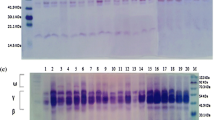Abstract
Transglutaminase (TG) enzyme was tested in T. aestivum and T. durum wheat-based model systems to evaluate the quality improvement to pasta imparted by cross-linking. Quality was measured by the enhancement in sensory and cooking properties. In this process, tests were also performed to establish the biochemical structure-functions of the proteins involved at TG enzyme concentrations between 10 and 200 mg kg−1. It was observed that the amounts of water/salt-, the alcohol- and the alkali-soluble protein fractions were reduced significantly. Change in the molecular weight distribution assessed by SDS PAGE was also noticed. The sensory properties were observed to improve from high water uptake and low cooking loss. The TG treatment changed the gluten structure in the modified pasta products. Immune-reactive gliadin fractions were detected by immunoblotting and independently measured by competitive indirect ELISA, using the anti-gliadin rabbit IgG.



Similar content being viewed by others
References
Kuraishi C, Yamazaki K, Susa Y (2001) Transglutaminase: its utilization in the food industry. Food Rev Int 17(2):221–246
Zhu Y, Rinzema A, Tramoer J, Bol J (1995) Microbial transglutaminase: a review of its production and application in food processing. Appl Microbiol Biot 44(3–4):277–282
Caballero PA, Gómez M, Rosell CM (2007) Improvement of dough rheology, bread quality and bread shelf-life by enzymes combination. J Food Eng 81:42–53
Motoki M, Seguro K (1998) Transglutaminase and its use for food processing. Trends Food Sci Tech 9(5):204–210
Bauer N, Koehler P, Wieser H, Schieberle P (2003) Studies on effects of microbial transglutaminase on gluten proteins of wheat I. Biochem Anal Cereal Chem 80:781–786
Seguro K, Kumazawa Y, Kuraishi C, Sakamoto H, Motoki M (1996) The ε-(γ-glutamyl)-lysine moiety in crosslinked casein is an available source of lysine for rats. J Nutr 126:2557–2562
Larré C, Denery-Papini S, Popineau Y, Deshayes G, Desserme C, Lefebvre J (1999) Biochemical analysis and rheological properties of gluten modified by transglutaminase. Cereal Chem 77(2):121–127
Rosell CM, Wang J, Aja S, Bean S, Lookhart G (2003) Wheat flour protein as affected by transglutaminase and glucose oxidase. Cereal Chem 80(1):52–55
Watanabe M, Suziki T, Ikezawa Z, Arou S (1994) Controlled enzymatic treatment of wheat proteins for production hypoallergenic flour. Biosci Biotech Biochem 58:388–390
Caballero PA, Bonet A, Rosell CM, Gómez M (2005) Effect of microbial transglutaminase on the rheological and thermal properties insect damaged wheat flour. J Cereal Sci 42:93–100
Basman A, Köksel H, Ng PKW (2002) Effect of increasing level of transglutaminase on the rheological properties and bread quality characteristics of two wheat flours. Eur Food Res Technol 215(5):419–424
Bonet A, Blaszczak W, Rosell CM (2006) Formation of homopolymers and heteropolymers between wheat flour and several protein sources by transglutaminase-catalyzed cross-linking. Cereal Chem 83(6):655–662
Köksel H, Sivri D, Ng PKW, Steffe JF (2001) Effects of transglutaminase enzyme on fundamental rheological properties of sound and bug-damaged wheat flour doughs. Cereal Chem 78(1):26–30
Gerrard IA, Fayle SE, Brown PA, Sutton KH, Simmons L, Rasiah I (2001): Effects of microbiological transglutaminase on the wheat proteins of bread and croissant dough. J Food Sci 66:782–786
Nielsen PM, Petersen BR, Moller AJ (1995) Impact of salt, phosphate and temperature on the effect of a transglutaminase on the texture of restructured meat. Meat Sci 41:293–299
Xiao QH, Spradlin JE (2001) Process for incorporating whey proteins into cheese using transglutaminase. United States Patent US 6224914 B1
Moore MM, Heinbockel M, Dockery P, Ulmer HM, Arendt EK (2006) Network formation in gluten-free bread with application of transglutaminase. Cereal Chem 83(1):28–36
Kuraishi C, Sato K, Tanaka H (1999) Method of producing breads (with transglutaminase and partial protein hydrolysates) and enzyme preparation. European Patent Application, EP 0 938 845 A1
Basman A, Köksel H, Atli A (2006) Effect of increasing level of transglutaminase on cooking quality of bran supplemented spaghetti. Eur Food Res Technol 223(4):547–551
Joint FAO/WHO Food standards programme CCMAS 26th Session, Budapest, Hungary, 8–12 March 2004
Karácsonyi L (1970) Gabona és liszt-, sütő- és tésztavizsgálati módszerek (Methods for examination of cereal flours, bakery- and pasta products). Mezőgazdasági Kiadó, Budapest 22–24
Magyar Szabvány (Hungarian Standard) (1985) MSZ 20500/3-1985. Magyar Élelmiszerkönyv (Codex Alimentarius Hungaricus). Hivatalos Élelmiszervizsgálati módszergyűjtemény (Collection of official methods for food analyses): Száraztészták vizsgálati módszerei: Érzékszervi tulajdonságok vizsgálata (Test methods of pastry products: Sensory test)
Feillet P, Fevre F, Kobrehel K (1977) Modification in durum wheat protein properties during sheeting of pasta dough. Cereal Chem 54:580–587
Laemmli UK (1970) Cleavage of structural proteins during the assembly of the head of bacteriophage T4. Nature 227:680–685
Gerrard IA, Newberry MP, Ross M, Wilson AJ, Fayle SE, Kavale S (2000) Pastry lift and croissant volume as affected by microbial transglutaminase. J Food Sci 65:312–314
Acknowledgment
The experiments were carried out with the financial support of Ministry of Agriculture and Regional Development of Hungary (No. 34 048/2003).
Author information
Authors and Affiliations
Corresponding author
Rights and permissions
About this article
Cite this article
Takács, K., Gelencsér, É. & Kovács, E.T. Effect of transglutaminase on the quality of wheat-based pasta products. Eur Food Res Technol 226, 603–611 (2008). https://doi.org/10.1007/s00217-007-0604-1
Received:
Revised:
Accepted:
Published:
Issue Date:
DOI: https://doi.org/10.1007/s00217-007-0604-1




